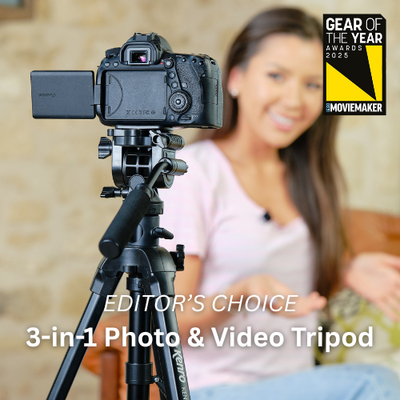Your beginner-friendly glossary of essential photography lingo – explained simply.
Photography can be a beautifully creative hobby or a thriving professional career, but getting to grips with all the jargon? That’s a different story.
Whether you're shooting on a DSLR, mirrorless camera, or even a smartphone, understanding key terms will help you take more control of your camera, improve your compositions, and confidently invest in gear that meets your needs.
Here’s your no-nonsense A–Z of essential photography terms, with explanations even complete beginners can understand. We’ve also included handy mentions of Kenro products that can help bring these terms to life.
-
A – Aperture
The adjustable opening in your lens that controls how much light hits the sensor. It also affects depth of field. Wider apertures (like f/2.8) blur the background beautifully, while smaller ones (like f/11) keep more in focus.
Try this: Use a Kenro tripod to keep your camera steady when shooting with small apertures and longer shutter speeds.
B – Bokeh
The soft, out-of-focus background blur in a photo. Often sought after in portraits and macro shots. Achieved with wide apertures and good lens quality.
C – Composition
How you arrange the elements of your photo. Great composition separates a snapshot from a stunning image. Learn the rule of thirds, symmetry, and leading lines.
D – Depth of Field
The zone of sharp focus in your image. A shallow depth of field isolates your subject; a deep one brings everything into focus.
E – Exposure
The amount of light that hits your camera’s sensor, controlled by aperture, shutter speed, and ISO. Getting a “correct exposure” means your photo isn’t too dark or too bright.
F – Flash
An artificial light source used to brighten scenes. Kenro’s flashes, including the Mini Speedflash, Standard Speedflash, and Macro Ring Flash, are perfect tools for learning how to shape and control your lighting.
G – Grain / Noise
Visual distortion in an image, especially in low light or high ISO settings. It appears as speckles or a lack of smoothness in colours and shadows.
H – Histogram
A graph showing the brightness levels in your image, from shadows (left) to highlights (right). It’s a handy tool for understanding exposure at a glance.
I – ISO
Your camera sensor’s sensitivity to light. Lower ISO (like 100) gives cleaner images in bright conditions. Higher ISO (like 3200+) helps in low light, but increases grain.
J – JPEG
A commonly used image file format. JPEGs are compressed and easy to share, but they lose some data compared to RAW files.
K – Kenro
We couldn’t skip this one! Kenro is a trusted UK-based brand that’s supported photographers since 1973, offering tripods, lighting, flashes, cleaning gear, frames, and more. Whatever stage you're at, Kenro helps you shoot smarter.
L – Lighting
Good lighting is everything. Whether natural or artificial, it defines mood, texture, and clarity. For ultimate control, try Kenro’s Smart Lite collection, from RGB panels to ring lights and compact COBs, there's something for every creator.
M – Manual Mode
A camera setting that gives you full control over shutter speed, aperture, and ISO. It’s the best way to learn how photography works.
N – ND Filter
Short for Neutral Density filter. It reduces light entering the lens without affecting colour, perfect for long exposures in bright conditions.
O – Optical Zoom
Zoom achieved using your lens's mechanics (not software), giving better image quality than digital zoom.
P – Prime Lens
A lens with a fixed focal length (like 50mm). Known for sharpness, speed, and better performance in low light.
Q – Quick Release Plate
A small mounting plate that lets you attach/detach your camera from a tripod quickly. Most Kenro tripods include this essential accessory.
R – RAW File
An uncompressed file that retains all image data captured by the sensor. It gives you greater control when editing exposure, white balance, and colour.
S – Shutter Speed
How long the camera’s shutter stays open. Fast speeds freeze motion; slow speeds create blur. Use a Kenro tripod when shooting long exposures for maximum sharpness.
T – Tripod
A three-legged stand that stabilises your camera. Essential for low-light, landscape, long exposure, and studio work. Explore Kenro’s Classic, Ultimate Travel, and Smart Lite grip tripods for every shoot.
U – Underexposed
A photo that’s too dark. Caused by not enough light hitting the sensor which can often be fixed by increasing ISO or using a Kenro LED Smart Lite for extra fill.
V – Viewfinder
The eyepiece you look through to compose your shot. Some cameras have digital (EVF) or optical viewfinders.
W – White Balance
A camera setting that corrects colour temperature, ensuring whites appear white and other colours stay accurate. Master this for cleaner, more professional-looking photos.
X – X-Sync
Short for flash sync speed. It’s the maximum shutter speed that will synchronise with your camera’s flash. Go above this, and part of your image may be blacked out.
Y – Yellow Cast
An unwanted yellow tint caused by incorrect white balance or poor indoor lighting. Using a Kenro Bi-colour Smart Lite allows you to match colour temperatures and eliminate colour casts.
Z – Zoom Lens
A lens that covers multiple focal lengths, like 24-70mm. Convenient and flexible and ideal for travel, events and everyday shooting.
-
Photography has a language all of its own, but once you get familiar with it, everything from buying gear to mastering techniques becomes easier and more rewarding.
Whether you’re setting up your first shoot or refining your lighting setup with the Kenro Smart Lite range, we hope this A–Z helped clarify some of the terms you’ll encounter on your journey.
Explore our full range of tripods, LED lights, flashes, frames, and cleaning accessories at kenro.co.uk designed for photographers at every stage of their story.


